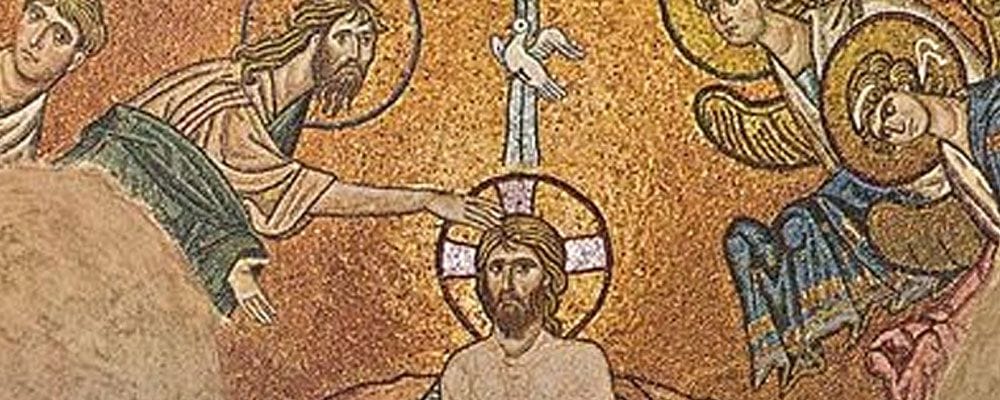
Themes and Significance of Holy Theophany
The Church prepares us for the great Feast of Holy Theophany through many special hymns and readings, introduced on the 2nd of January and continuing until the ninth day after the Feast (January 14th).
The main themes developed are the following:
1) The appearance or manifestation of God (Theophany)
What God? Our God: God the Father, God the Son, and God the Holy Spirit. As the Troparion of the Feast proclaims, on this day “worship to the Holy Trinity was revealed.” The three divine Persons reveal themselves in a unique way to the world.
2) The appearance in the flesh of God Himself (Epiphany)
What God? Our God: Jesus Christ. “True God of true God,” as we recite in the Creed. As the Evangelist says: “The Life was made manifest.” And as the Kontakion of the day says: “Today Your Light, O Inaccessible Light, has shone upon us.”
3) The theme of light, which gave the name to the Feast: Τα Φωτα, the Feast of Lights.
Of course it was a special day of enlightenment, of illumination (baptism) for those who on this day descended into the water to be buried and then rise with the Lord. That’s why instead of the Trisagion Hymn we sing: “Those of you who have been baptized in Christ, have put on you Christ the Lord. Alleluiah!”– a reminder that the Catechumens were baptized on this day.
4) The Ayiasmos, or sanctification of the water
This happens through the invocation and descent of the Holy Spirit. Indeed it is a great mystery (mysterion) of the Church. The blessed water becomes in turn a blessing of soul and body, healing of sufferings, and source of grace and power for the believer.
5) A cosmic event
Not only is man reconciled with God through Jesus Christ, but with the entire creation, which as a result of man’s fall had also fallen, is now reconstituted. So does the Church chant: “By Your bodily appearance the land was sanctified, the waters blessed, the sky illumined; and the race of mortals is redeemed from the bitter tyranny of the Foe.”
6) Cleansing
We want this holy water to become a cleansing agent for us, so “that those who drink it, may be purified in soul and body,” as we say in a prayer. We want to learn from our Lord’s example to be obedient and humble, contrary to what the world preaches. We want to bury the “old Adam,” the nature which resists God’s grace, and emerge renewed, regenerated, transformed.
7) St. John the Baptist’s role
The Church praises, honors and extols St. John the Baptist, for having laid his hands on the head of Jesus Christ. It also speaks of Christ’s condescension and humility in accepting baptism at his hands. Christ frees us by accepting to come in the form of a servant and voluntarily submit Himself to the servile act of bending His neck. What about us, who receive Him mystically, but really, in our hearts?
The significance of the Feast is pointed out by the hymnology of the Church in a variety of contrasted and poetic images:
At Christmas we celebrated the manifestation in the flesh of God; at Epiphany we celebrate the manifestation of the divinity in man.
- Christmas was a joyous Feast, but Theophany is glorious. There we saw man, Magi and shepherds, witnessing Christ’s divinity; here the First and Third Person of the Holy Trinity give witness to the Second Person of the Holy Trinity, who was incarnated.
- In Bethlehem we were still Jews, following the Judaic rituals and requirements of the Law. In Jordan we have crossed Judea and the desert to adore the true God, manifested as Trinity.
- God the Father gave Moses the Law; today He gives us the Law-Giver.
- In Eden Adam and Eve were despoiled of their glory and were rendered naked. In Jordan their garment of incorruption was restituted by Christ.
- In Eden we were impoverished; here we are enriched.
- With an act of disobedience Adam lost his freedom; with an act of obedience the New Adam regains our freedom.
- By cleansing Himself Christ cleanses humanity, from Adam all the way down to us.
- The water of Jordan is sanctified by the Water of Life.
- From water sprung life; from water springs the new life in Christ.
- Christ stripped Himself of His clothing to enter Jordan, in order to cloth us with a garment of incorruption.
- As Christ buried the ancestral sin in the waters of Jordan, we too buried our sins in the waters of the baptismal font. There will be another baptism, that of fire. We should prepare ourselves for it.
- Having being washed by the baptismal waters, let us remain clean. But should we soil the baptismal garment, let us cleanse it with our tears of repentance.
Christ came in the form of a servant for our sins:
– To destroy the Devil, lurking in the waters
– To purify and sanctify the waters
– To show the way of baptism to us
– To “pave” our regeneration through water and Spirit
– To reestablish sonship: “You are (in Your human form) my beloved Son.”
Father, thank you again for leading us deeper into our faith.